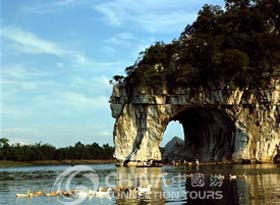
 Elephant Trunk Hill is one of the Lijiang River's most famous sights. The hill is situated on the western bank of the Lijiang River, to the southeast of Guilin. It looks like an elephant, dipping its snout into the Lijiang River, hence the name "Elephant Trunk Hill". This sight is very representative of the landscape around Guilin and is a symbol of Guilin itself. A park and a Ming Dynasty pagoda are found on and around the Elephant Trunk Hill.
Elephant Trunk Hill is one of the Lijiang River's most famous sights. The hill is situated on the western bank of the Lijiang River, to the southeast of Guilin. It looks like an elephant, dipping its snout into the Lijiang River, hence the name "Elephant Trunk Hill". This sight is very representative of the landscape around Guilin and is a symbol of Guilin itself. A park and a Ming Dynasty pagoda are found on and around the Elephant Trunk Hill.
Originally named "Li Hill", "Yi Hill" and "Chenshui Hill", the hill has a history of 3.6 hundred million years. Resembling elephant leisurely sucking water from the river with its long trunk, this hill is famous as Elephant Trunk Hill for hundreds of years. Legend says that an elephant that belonged to the Emperor of Heaven came down to earth to help the people in their work. This angered the Emperor of Heaven, who stabbed the elephant as it was drinking at the river's edge and turned it to stone.
With an elevation of 200 meters, the hill towers 55 meters above the water, measuring 108 meters in length and 100 meters in width. Between the trunk and the legs of the elephant is a cave, in the shape of a full moon, penetrating the hill from side to side, and people named it "Moon-over-Water Cave". When the waters wave and the moonlight gleam, the scene is exceedingly enchanting. On the walls in and around this cave, over 70 inscriptions from the Tang and Song dynasties were found, praising the beauty of hills and waters nearby; the most well-known of which is a poem by Lu You (1125-1210), one of the four great poets of the Southern Song dynasty (1127-1279). Halfway up the hill lays another cave, which goes through the hill and serves as the eyes of the elephant, through which visitors can overlook the beautiful scene of Guilin city. A narrow winding path leads to the top of the hill and the Samantabhadra Tower. Built from solid brick and dating from the Ming dynasty (1368-1644), the tower is round like a bottle or the handle of a sword, so the tower is also referred to as the Precious Bottle Tower or the Sword Handle Tower.

